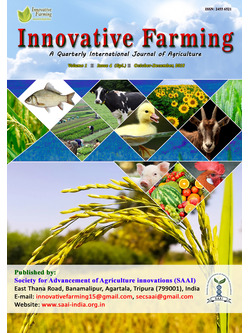
Soil Carbon Sequestration to Mitigate Climate Change and Food Insecurity
Pradeep Kumar*
Dept. of Agronomy, CCS Haryana Agricultural University, Hisar, Haryana - 125004, INDIA
Sandeep Kumar
Dept. of Agronomy, CCS Haryana Agricultural University, Hisar, Haryana - 125004, INDIA
S.K. Kakraliya
Dept. of Agronomy, CCS Haryana Agricultural University, Hisar, Haryana - 125004, INDIA
C.K. Jangir
Dept. of Agronomy, CCS Haryana Agricultural University, Hisar, Haryana - 125004, INDIA
DOI: NIL
Keywords: Climate change, Food insecurity, Mitigation, Carbon sequestration
Abstract
Climate change caused by increased temperature and atmospheric carbon-dioxide concentration has brought the global food insecurity. The natural global carbon cycle has been disturbed with increased human induced CO₂ emission. Soil carbon sequestration is a major means to overcome this concern by transferring the atmospheric CO₂ into soil for long term use by means of proper land use and agronomic practices. The prime object for the effort is to slow down the rapid rise of carbon dioxide in the atmosphere. Upon sequestering the atmospheric CO₂ into the soil, the atmospheric CO₂ level gets reduced and beside this, soil organic carbon releases nutrients for plant growth, promotes the chemical, biological and physical properties of the soil, and acts as a buffer against harmful substances which ultimately enhances the crop production. Soil organic carbon is part of the natural carbon cycle, and the world’s soils hold around twice the amount of carbon that is found in the atmosphere and in vegetation. Organic carbon gets assimilated within the plant system through photosynthesis using carbon dioxide from the air and water. The vegetative parts, animals, human and other living beings after death return to the soil where they are decomposed and recycled. It increases agricultural production with enhanced soil physical, chemical and biological properties and facilitates environmental benefits leading to improved food system stability to fight world hunger.
Downloads
not found
Reference
Baker, J. M., Ochsner, T. E., Rodney, T., Venterea, R. T., and Griffis, T. J. (2006). Tillage and soil carbon sequestration—What do we really know? Agriculture, Ecosystems & Environment, 118(1–4), 1–5.
Carter, M. R. (2002). Soil quality for sustainable land management: organic matter and aggregation interactions that maintain soil functions. Agronomy Journal, 94, 38–47.
Sauerbeck, D. R. (2001). CO₂ emissions and C sequestration by agriculture—perspectives and limitations. Nutrient Cycling in Agroecosystems, 60, 253–266.
Franzluebbers, A. J., Haney, R. L., Honeycutt, C. W., Arshad, M. A., Schomberg, H. H., and Hons, F. M. (2001). Climatic influences on active fractions of soil organic matter. Soil Biology & Biochemistry, 33, 1103–1111.
Gregorich, E. G., Drury, C. F., and Baldock, J. A. (2001). Changes in soil carbon under long-term maize in monoculture and legume-based rotation. Canadian Journal of Soil Science, 81, 21–31.
Keith, D. W. (2009). Why capture CO₂ from the atmosphere. Science, 25(325), 1654–1655.
Post, W. M., and Kwon, K. C. (2000). Soil carbon sequestration and land-use change: processes and potential. Global Change Biology, 6(3), 317–327.
Prentice, I. C. (2001). The carbon cycle and the atmospheric carbon dioxide. In Climate Change 2001: The Scientific Basis, IPCC, Cambridge University Press, UK, pp. 183–237.
Schlesinger, W. H. (1999). Carbon sequestration in soils. Science, 284(5423), 2095.
West, T. O., and Marland, G. (2002). Net carbon flux from agriculture: methodology for full carbon cycle analyses. Environmental Pollution, 116, 439–444.
Trevors, J. T. (2015). Climate change: agriculture and hunger. Water Air Soil Pollution, 205(1), 5105.
